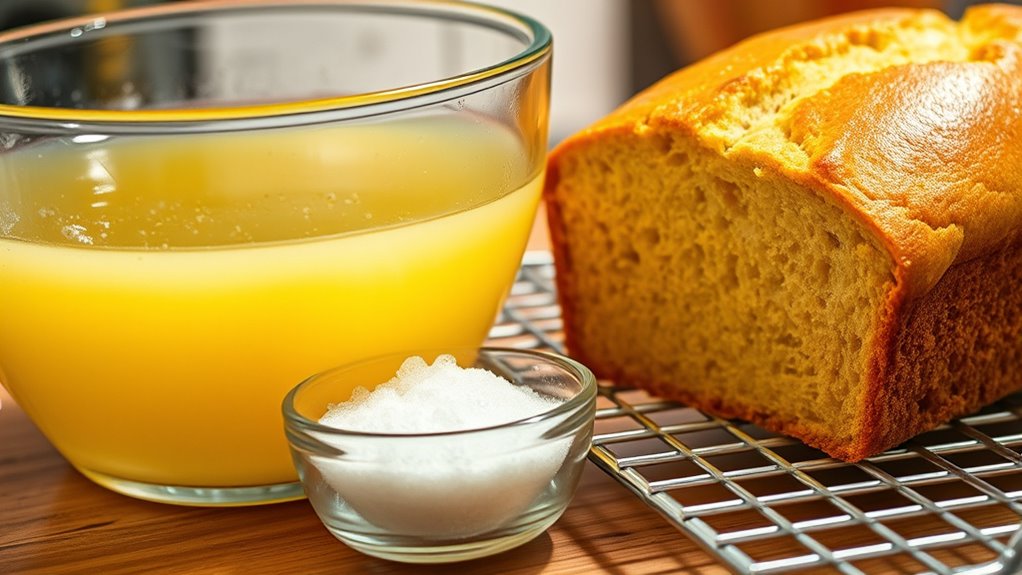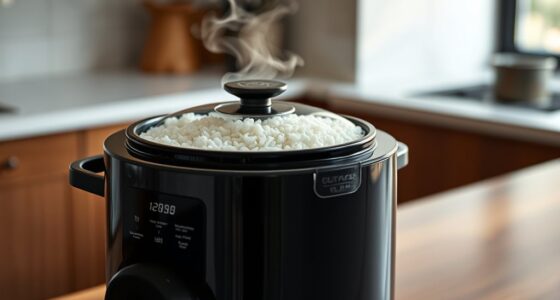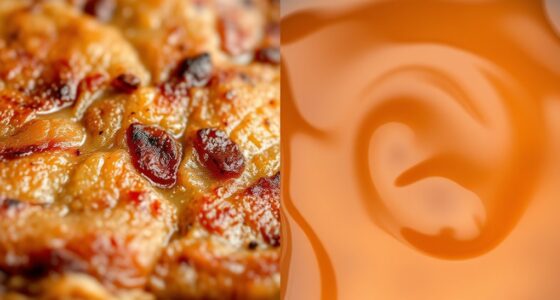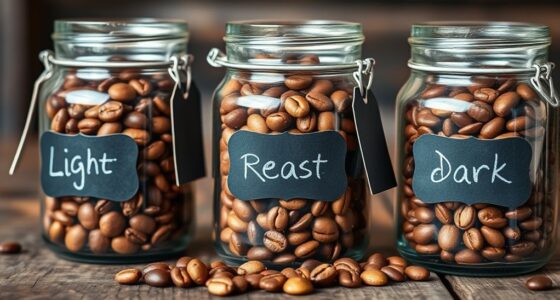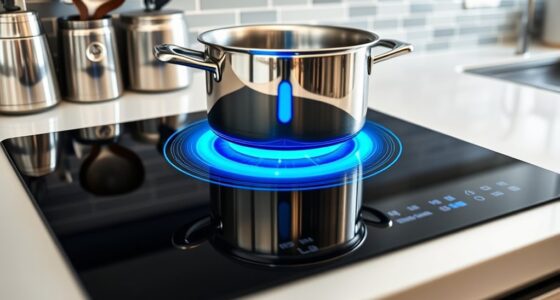Adjusting acidity levels in your baking ingredients influences the texture, flavor, and rise of your baked goods. By tweaking pH, you can achieve a tender crumb, better leavening, and richer coloration through Maillard reactions. Proper acidity balances flavors and enhances ingredient interactions, like gluten development. It also impacts browning and shelf stability. Understanding how acidity transforms your baking helps you craft more consistent, flavorful treats—keep exploring to discover even more baking secrets.
Key Takeaways
- Adjusting acidity influences crumb texture, tenderness, and rise by affecting leavening agents and gluten development.
- Proper acidity enhances flavor brightness and balances subtle tastes for more vibrant baked goods.
- Incorporating acidic ingredients like yogurt or lemon modifies ingredient interactions, improving color and moisture.
- Controlling pH levels during storage ensures ingredient stability and consistent baking results.
- Experimenting with acidity allows for optimized leavening, improved texture, and more visually appealing baked treats.
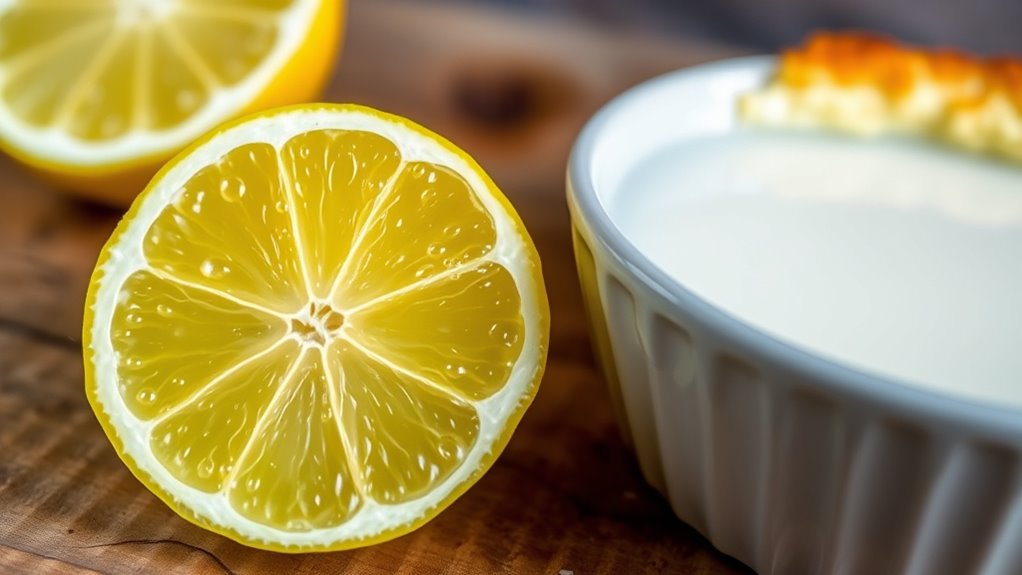
Understanding how acidity levels influence your baking can make a significant difference in the outcome of your baked goods. When you pay attention to the pH balance of your ingredients, you reveal the potential to improve texture, rise, and overall flavor. Acidity plays a vital role in how your baked items develop, affecting everything from the crumb structure to the taste profile. For example, adjusting the pH balance can help you achieve a tender crumb in cakes or a crisp exterior on cookies. Recognizing how acidity interacts with leavening agents like baking soda or baking powder allows you to control the rise and prevent overly dense results.
Flavor enhancement is another key aspect influenced by acidity. A well-balanced level of acidity can brighten flavors, making your baked goods taste more vibrant and appealing. For instance, adding a splash of lemon juice or vinegar can elevate the depth of fruit fillings or batter, giving them a fresh, lively taste. Conversely, too much acidity can overpower subtle flavors, so understanding how to fine-tune pH levels helps you create harmonious, well-rounded treats. You might find that a small adjustment in acidity can turn a bland cake into a flavorful masterpiece, or a dull muffin into one bursting with character.
In baking, acidity also affects ingredient interactions, especially with dairy products like buttermilk or yogurt. These ingredients are naturally acidic and can be used intentionally to modify the pH balance of your dough or batter. When you incorporate them thoughtfully, you enhance both the flavor and the texture, often resulting in a lighter, more tender crumb. Additionally, acidity can influence browning during baking. Slightly more acidic environments promote Maillard reactions and caramelization, giving your baked goods a richer color and deeper flavor.
Another important aspect is that storage conditions can influence the stability of ingredients and their acidity levels, ultimately impacting your baked goods’ quality. It’s important to remember that balancing acidity isn’t just about adding acidic ingredients but also about understanding how they work with your other components. For example, the pH level affects gluten development, which in turn impacts the elasticity and structure of bread dough. By controlling acidity, you can optimize gluten formation for a chewy bagel or a fluffy loaf. Experimenting with different acidic ingredients and observing their effects on flavor and texture helps you develop a more intuitive sense of pH balance in your recipes. Ultimately, mastering the role of acidity in baking empowers you to craft baked goods that are not only visually appealing but also bursting with flavor and perfect in texture.
Frequently Asked Questions
How Does Acidity Affect Gluten Development in Baked Goods?
You might notice acidity impacts gluten development by altering the pH balance of your dough. When acidity increases, the pH drops, which can weaken gluten structure, making it less elastic and more fragile. Conversely, a balanced pH helps strengthen gluten, giving your baked goods better texture and rise. So, controlling acidity levels is essential for achieving the desired gluten development and overall quality in your baked creations.
Can Adjusting Acidity Replace Baking Soda or Baking Powder?
Think of acidity as a secret weapon in baking. While adjusting acidity with substitutes like lemon juice or vinegar can enhance flavor and sometimes help leaven, it can’t fully replace baking soda or powder. Acidic substitutes provide flavor enhancement and react with leavening agents, but for proper rise, you still need those key leaveners. Use acidity carefully, like a good seasoning, to complement, not substitute, the chemical reactions essential for perfect baked goods.
What Are Natural Ways to Modify Acidity in Recipes?
To naturally modify acidity in recipes, you can use fermentation techniques like sourdough starters or yogurt, which introduce beneficial acids. Citrus substitutions, such as lemon or lime juice, also boost acidity easily. You can experiment by adding these ingredients to adjust pH levels, enhancing flavor and leavening without relying on commercial baking agents. These methods help you control acidity naturally, improving your baking outcomes.
How Does Acidity Influence the Shelf Life of Baked Products?
Acidity considerably impacts the shelf life of baked products by enhancing preservation effects and maintaining flavor stability. When you increase acidity, it creates an environment less favorable for bacteria and mold growth, extending freshness. Conversely, lower acidity may speed up spoilage. By balancing acidity levels, you guarantee your baked goods stay fresher longer, preserving their flavor and texture, and reducing waste. Proper acidity management is essential for ideal shelf life and quality.
Are There Specific Ingredients That Significantly Alter Acidity Levels?
Did you know that adding just a teaspoon of lemon juice can lower your batter’s pH by nearly 0.5? Certain ingredients like citrus, vinegar, buttermilk, and yogurt substantially alter acidity levels, impacting pH balancing in baking. These ingredients increase acidity, which can improve leavening and flavor. Understanding ingredient acidity helps you control your baked goods’ texture and rise, making your baking consistently delicious.
Conclusion
Understanding acidity levels can truly elevate your baking game. Did you know that adjusting acidity can increase leavening efficiency by up to 30%? By mastering this, you’ll notice lighter cakes, fluffier bread, and more balanced flavors. So, next time you bake, remember that a simple tweak in acidity could make all the difference. Keep experimenting, and you’ll discover even more delicious possibilities in your kitchen. Happy baking!
